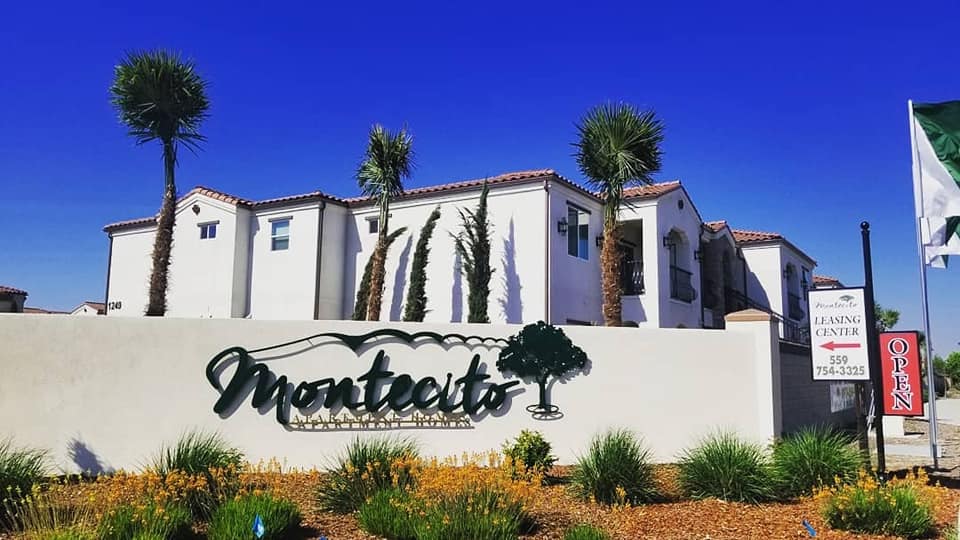
Multifamily construction is off to a strong start for 2022 in Visalia after years of stagnancy. Seen here are the high-end Montecito Apartments.
Written by
Correction: This story was updated to reflect that Akers Riggin LLC is the owner of the apartments being built by Ginder Development.
Permit numbers are proof that construction in Visalia hasn’t just been limited to the industrial sector. After 10 years of meager multifamily growth, 2022 has jumped off and developers are seeing potential in the Visalia rental market.
To date, the 287 apartment units permitted this year represent just under 30% of all the multifamily units permitted to be built in the past 10 years. It’s a similar story looking at square footage. The 306,707 square feet of development permitted this year represents 30.69% of the 109.4 million square feet of multifamily permitted in the last decade.
And there’s still six months to go.
Going back to 2013, no apartment units were permitted in the City of Visalia, according to permitting documents with the City. That number began to grow slowly with 10 permits issued the next year, bringing 20 units online. From 2015 to 2020, there were only two years where more than 100 units were allowed in a single year.
Following 2020, when only three permits were issued, the number jumped to 58, bringing 204 units to the Visalia market.
It was Rick Ginder’s Montecito Apartments that recently illustrated how high-end, multifamily complexes could be done in Visalia, said Robin Kane, senior vice president with the Mogharebi Group, a real estate brokerage specializing in multifamily real estate.
Near Highway 198, the high-end apartment complex provides access to not only Highway 99, but also the non-stop development along Riggin Avenue, where Amazon, UPS and Ace Hardware are building distribution centers.
Devon Jones, Visalia’s economic development manager, said the 171% jump in multifamily development this year represent projects that have been in the pipeline and are now through the entitlement processes.
“We’re seeing that development activity come to fruition now,” Jones said.
In the last week of June, permits were issued for seven parcels of land with eight units each along West Sedona Avenue between Demaree and North County Center streets. Ginder Development was listed as the contractor. Ginder’s Akers Riggin LLC is the owner of the project. Visalia-based BJ Perch Construction Inc. was the applicant.
A representative with Ginder Development was not immediately available for comment.
Valuations for those properties range from as low as $796,154 for an 8,333 square-foot lot to as high as $973,122 for a 10,326 square-foot lot, according to the permits.
The rise in housing comes with the rise of industrial development. The “Sun Gazette” newspaper in Exeter reported that the unemployment rate in Tulare County had reached its lowest number since it began tracking the data in 1990.
But a significant problem, said Kane, has been the lack of workforce-level apartments.
A single-bedroom unit at the Montecito begins at $2,050, going as high as $2,527, according to the apartment website.
Average rents in Visalia reached $1,627 in February, catching up to national averages after being historically low, according to data from rentcafe.com.
Ideally, when a high-end apartment comes on the market, that should free up other units when renters upgrade. But the lack of apartment development in the past created a bottleneck of available housing.
Apartment construction in Visalia has historically been difficult, said Kane. Development can be more expensive than in other areas.
Many of those complexes will undergo renovations to bring rents back up to market rate, shrinking even more the availability of workforce housing.
The pressure of rising interest rates also works to keep renters from upgrading to homes for a longer period.
“If your average stay is 12 to 15 months or eight to 12 months, that just got extended by 30%, easy, easy,” Kane said. “So now all of a sudden that tenant that was saving money, doing all of these things, now has to realize they have to save money for another six months, another year.”
A sudden rise of new apartment construction presents another challenge for developers, said Kane. With a glut of units coming all at the same time, those complexes end up competing for the same renters. The rental market hasn’t hit that point yet as Visalia can still absorb much more, Kane said.
The canary in the coal mine is what Kane calls “the balloon factor.”
Instead of renting out 10-12 units a month, that number may go down to five or six when renters have more options. To attract more renters, drivers-by may notice balloons at entrances to draw attention and let people know that they have units available. They may advertise free rent or other concessions.
“When you start seeing those balloons pop up, numbers aren’t being hit, expectations aren’t being met,” Kane said.
In the scheme of things, though, apartment construction in Visalia and elsewhere is merely catching up to where it needs to be, said Kane.
“It’s going to be a long time before I tell you we have too many apartment complexes,” Kane said.








